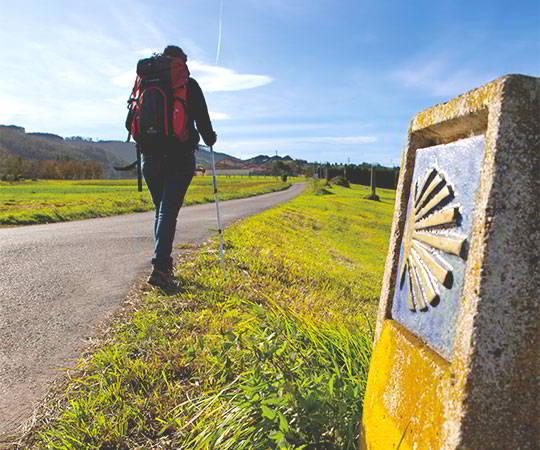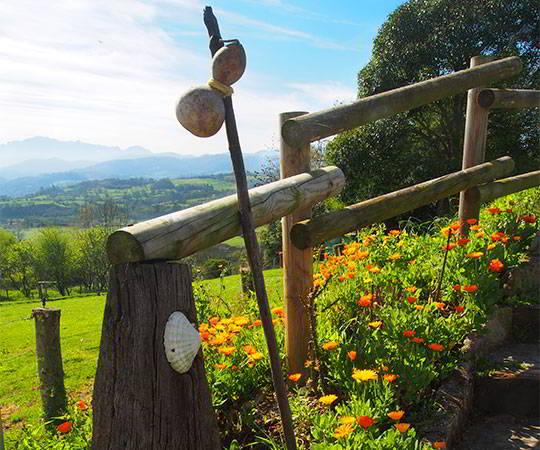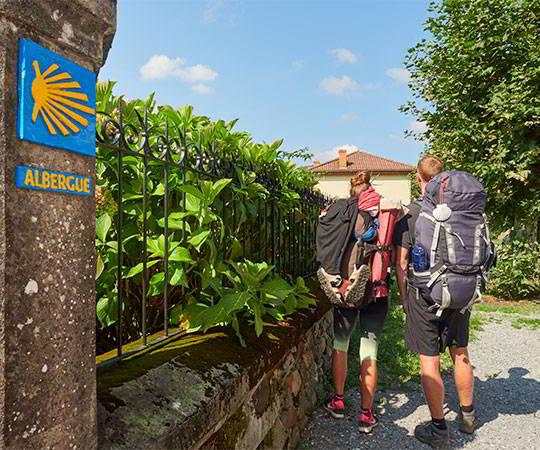The Camino de Santiago is a comforting experience, but also a tough one. It is advisable to be in good physical shape and to do a little exercise before setting out on the journey.
/documents/39908/67671/peregrino-senal.jpg/e7837e27-a02b-40f8-5b97-76cf2a311061?t=1729666870644

Signposting of the Way of St. James.
The Pilgrims' Route to Santiago is divided into stages that begin and end in different towns and villages, in whose hostels -private or public- you spend the night. The route is signposted with the image of a scallop, a typical mollusc of the Galician coast, which has been a symbol of the pilgrimages to Santiago de Compostela since the Middle Ages. This is due to the fact that the first walkers to the tomb of the apostle used to hang a scallop shell from their costume once they reached Santiago, so that on the way back to their homes those who passed them would know that they were returning from Compostela.
It is advisable to start walking a few months before starting the pilgrimage, and to wear comfortable footwear that has been worn before. It is advisable to wear sandals or flip-flops to put on once at the destination, when you need to let your feet breathe. Sun cream, a mackintosh and a minimum first-aid kit for emergencies should be carried, but the backpack should not be too heavy. The recommendations insist that it should not weigh more than ten kilos. A torch, hand-held or headlamp, and a walking stick are also essential tools.
The Compostela
All pilgrims must obtain their credentials. Although the majority of pilgrims take a booklet with boxes in which they stamp the successive stamps on their route, any medium is sufficient to record their journey to Santiago. A simple notebook is enough to obtain the relevant stamp from each place they pass through. Churches, hostels, tourist offices and other establishments have stamps to prove that you are doing the Camino.
The stamps allow you to stay in hostels and at the end of the Camino you can obtain the Compostela, a certificate issued in Santiago Cathedral to those pilgrims who have covered a minimum of 100 kilometres on foot or on horseback and 200 kilometres by bike.
/documents/39908/67671/compostela.jpg/42d7607e-98ac-ead4-e8d2-20c143f110a5?t=1729666235154

San Juan Villapañada Pilgrims' Hospice (Grado).
Sleeping on the Camino
/documents/39908/67671/donde-dormir.jpg/40689079-f728-58da-3f4f-3d218a8b8806?t=1729667507034

Pilgrims' hostel (Salas).
Given that the Camino is done walking, it is clear that a good rest makes things much easier when it comes time to put on the boots, put the backpack on your back and start a new stage.
The Jacobean routes that pass through Asturias have a sufficient number of establishments so that all pilgrims find a refuge in which to sleep a good night's sleep at the end of each stage.
In addition to the public hostels, there are also privately owned hostels, and in addition to these there is a wide range of accommodation, such as hotels and guesthouses, which proliferate in many of the towns, villages and villages along the following itineraries.
A different experience
In this section you will find a series of initiatives, which are available to pilgrims, to make this experience a little different.
Luggage transport on the Camino
If you do not want to carry your luggage on your back, there are companies that transport your things from one accommodation to another, so you only have to focus and concentrate on enjoying all that the Camino de Santiago has to offer, whatever route you have chosen.
More information and specific conditions:
El Camino with Correos(opens in a new tab).
Taxicamino(opens in a new tab)
Pilgrim's Pass in the Cider Shire
Get the best rest, enjoying the accommodation in the Cider Shire with a very special proposal.
More information and specific conditions:
